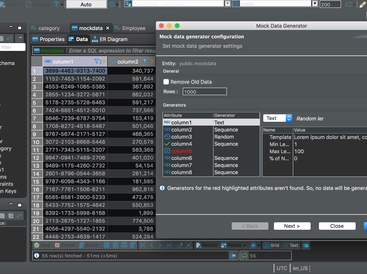
Overview
DBeaver is a free, multi-platform database tool that I’ve often recommended to developers, SQL programmers, administrators, and analysts who need something both robust and powerful. Built on JDBC driver support while also handling non-JDBC sources, it makes connections to major systems like MySQL, SQLite, PostgreSQL, Oracle, Microsoft SQL Server, IBM DB2, and Firebird very smooth. Its SQL editor helps you execute queries, manage tables, scripts, triggers, and even stored procedures with ease. The ERD visualization adds clarity when dealing with complex schema, and the metadata view is great for detailed analysis. I’ve found its data export, data import, and migration capabilities especially helpful when moving projects across systems. You can also download GitHub Desktop
From a daily-use perspective, what makes DBeaver stand out is its intuitive editor, advanced options, and overall flexible database management style. With open-source roots and even an enterprise edition available, it adapts to different DBAs and teams who value collaboration and extensible plugins. Its utilities support administration, organization, and management tasks while keeping query execution efficient. I personally like how cross-platform it is, running consistently across Windows, macOS, and Linux, and how it boosts productivity with visualization and entity-relationship tools. With ODBC support and compatibility across so many systems, it’s a versatile manager that handles both small and large databases while maintaining stability and strong performance.
⚡ DBeaver Free Download for Windows – Universal Database Management Tool
DBeaver is a powerful and versatile database management application designed for developers, database administrators, and analysts. Supporting a wide range of databases, including MySQL, PostgreSQL, Oracle, SQL Server, SQLite, and many more, DBeaver simplifies database connectivity, management, and querying in a single unified interface.
Its open-source nature, combined with advanced features like ER diagrams, data export, visual query building, and secure connections, makes DBeaver one of the most reliable tools for managing databases of all sizes. Whether you are handling small projects or enterprise-level systems, DBeaver provides the flexibility and performance you need. Also Try QuickViewer



✨ Features and Highlights
⚡ Cross-Database Support – Works seamlessly with MySQL, PostgreSQL, Oracle, MariaDB, SQL Server, SQLite, DB2, and many others.
📑 SQL Editor with Auto-Completion – Write and execute queries with syntax highlighting, auto-complete suggestions, and formatting tools.
📊 Data Visualization & ER Diagrams – Generate entity-relationship diagrams to visualize and manage complex database structures.
🔐 Secure Connections – Supports SSH tunneling, SSL, and strong authentication for secure database access.
📂 Data Import & Export – Export data in multiple formats including CSV, JSON, XML, and Excel for flexible reporting and analysis.
📈 Performance Monitoring – Analyze execution plans and monitor database performance in real time.
🖥 User-Friendly Interface – Modern tab-based design allows easy navigation between multiple connections and queries.
🔄 Open Source & Extensible – Free to use with community support and additional enterprise features available.
📥 How to Install DBeaver on Windows
- Download the latest DBeaver installer for Windows from the link below.
- Run the setup file and follow the installation wizard.
- Select your database drivers during setup or add them later from within the app.
- Launch DBeaver, create a new database connection, and start managing your data.
👉 Download Telegram Desktop for Windows – Free
💡 Why Use DBeaver?
- Unified platform for working with multiple database types.
- Open-source and free with extensive community support.
- Secure database connections with SSH and SSL.
- Powerful SQL editor with debugging and formatting tools.
- Visual query building and ER diagrams for simplified database design.
🖥 System Requirements
- OS: Windows 7, 8, 10, 11 (64-bit recommended)
- CPU: Intel/AMD dual-core processor
- RAM: 4 GB minimum (8 GB recommended for large databases)
- Storage: 200 MB available space
- Internet: Required for downloading database drivers and updates
🧠 Power Tips
- Use keyboard shortcuts in the SQL editor to boost productivity.
- Enable ER diagram generation to better understand complex database schemas.
- Save and manage multiple connection profiles for switching between databases quickly.
- Utilize data export to Excel or CSV for quick reporting and sharing.
- Install plugins from the DBeaver marketplace to extend its functionality.




